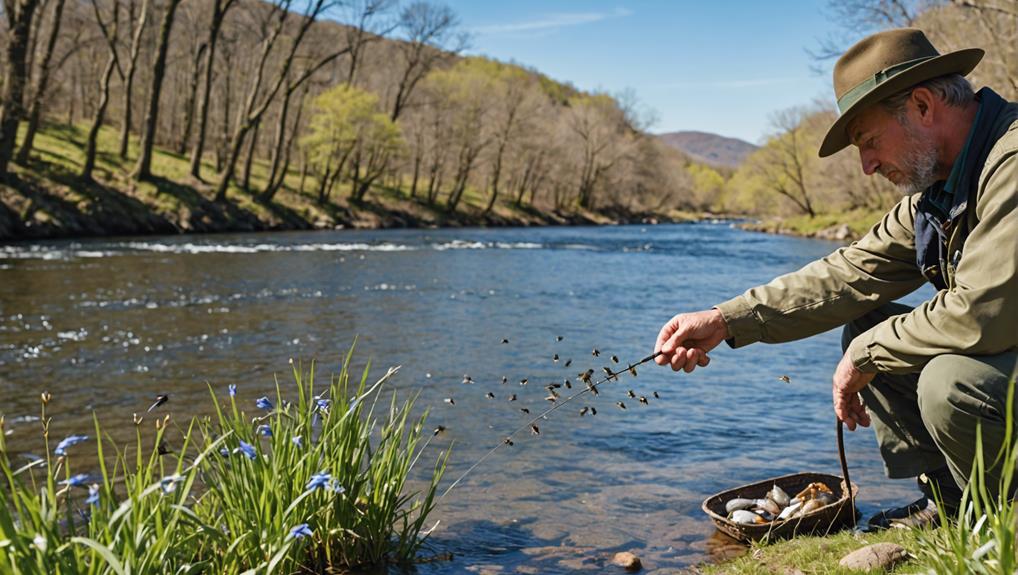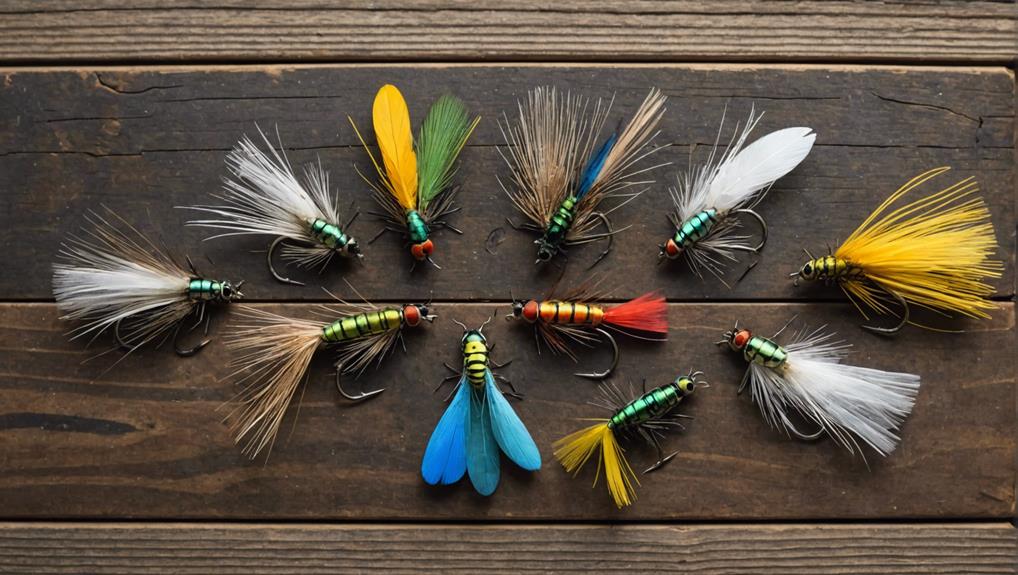In April, enhance your trout fishing success by arming yourself with these top flies. Start with the versatile Parachute Adams, perfect for mimicking mayflies. Don’t overlook the Blue-Winged Olive, especially effective in cooler weather. The Stonefly is essential for this time of year. For sub-surface strategies, the Prince Nymph and Emerging Caddis are indispensable as they accurately mimic underwater prey behaviors. Streamers like the Wooly Bugger and Marabou Muddler Minnow thrive in moderate flows, imitating larger prey. With this arsenal, you’re set for a productive outing. Explore these tips to further refine your technique and master the waters.
Key Takeaways
- Use Blue-Winged Olive flies on overcast, cooler days for effective trout fishing.
- Employ Parachute Adams to mimic a variety of mayfly species in diverse conditions.
- Try Zebra Midges and Mercury Baetis to match the natural midge larvae and adults during April.
- Cast Stonefly patterns like Double Bead Head Biot Stone in fast, oxygen-rich streams.
- Incorporate Soft Hackle Caddis to effectively mimic emerging caddis behavior near the surface.
Parachute Adams Essentials
The Parachute Adams, a versatile dry fly pattern, excels in mimicking mayflies and remains highly visible across various aquatic environments, ensuring you can effectively target rising trout. Central to its design is the choice of hackle, important for maintaining its buoyancy and visibility. You’ll want to select hackles that are stiff and well-barbed, as these characteristics help the fly remain afloat and maintain its form on the water’s surface. Ideal hackles for the Parachute Adams are typically from the neck or saddle of a rooster, with colors matching the natural mayflies in your fishing area.
When tying this fly, focus on achieving a balanced parachute hackle. This not only enhances its floatation but also makes it more enticing during mayfly hatches. Remember, the size of the fly is important; choose sizes between #12 and #20 to match the prevalent mayfly species during April. This range covers you for most situations, from large hatches to more selective feeders.
In terms of fishing tips for mayfly imitations, always observe the water before casting. Look for where trout are actively rising and adjust your technique to present the Parachute Adams effectively. A gentle upstream cast with a delicate presentation often yields the best results, making it a top choice during the hatches.
The Versatile Prince Nymph
As you explore the Prince Nymph, understanding its origins is essential. This pattern wasn’t just created; it evolved from the need to mimic various aquatic insects effectively.
Next, we’ll simplify the tying techniques, ensuring you can craft this essential fly with ease and confidence, regardless of your experience level.
Prince Nymph Origins
Originating in the 1930s in California, the Prince Nymph was crafted by Doug Prince and quickly became a favorite for mimicking a variety of aquatic insects. Doug’s innovative design, featuring a peacock herl body and distinctive white wings, makes it a versatile choice in your fly box. Here’s a quick glance at its core attributes:
| Feature | Description |
|---|---|
| Body Material | Peacock Herl |
| Hackle | Brown |
| Wings | White Goose Biot |
Its proven effectiveness lies in its ability to resemble multiple insect species, adapting seamlessly to different water conditions. You’ll find it indispensable when you’re out on the streams in April, making every cast count.
Tying Techniques Simplified
Let’s explore the simplified tying techniques for the versatile Prince Nymph, ensuring you can master this essential pattern with ease. Here’s how you can efficiently tie this effective fly:
- Start with the Bead Head: Attach a bead head to your hook to help the nymph sink quickly, important for successful nymphing.
- Add Peacock Herl: Wrap peacock herl around the shank to form the body, imitating the natural gloss of aquatic insects.
- Tie in Brown Hackle: Secure a brown hackle at the thorax and wrap it backward to create lifelike legs.
- Adjust Size and Color: Vary size and color based on local water conditions and insect species, enhancing fly selection and casting techniques.
Master these steps, and you’ll enhance your tying tricks and nymphing tips!
Blue-Winged Olive Tactics

As you target the elusive trout during April on the Welsh Dee, recognizing the Blue-Winged Olives amidst their hatch is essential.
You’ll find that overcast, cooler days provide the ideal conditions for these mayflies, setting the stage for a successful day on the river.
Mastering the art of presenting flies like the Parachute Adams or Sparkle Duns effectively can make all the difference in enticing those selective feeders to strike.
Identifying Blue-Winged Olives
To successfully identify Blue-Winged Olives, you’ll need to recognize their distinctive olive and gray shades and familiarize yourself with the species’ typical emergence patterns. Here’s a quick guide:
- Color: Look for the olive body and gray wings that characterize BWOs.
- Size: These mayflies are generally small; exact size can vary among species like Baetis tricaudatus and Baetis brunneicolor.
- Season: BWOs mainly hatch in cooler weather, making spring particularly active.
- Behavior: Observe the water surface for subtle rises that indicate feeding trout on emerging BWOs.
Understanding these elements will enhance your BWO identification skills and help you predict their seasonal patterns, essential for planning successful fishing trips.
Optimal Fishing Conditions
You’ll find that overcast days with cooler temperatures provide the best conditions for Blue-Winged Olive hatches, making these times ideal for dry fly fishing. These weather patterns guarantee the water remains calm, essential for the delicate hatches of these olives.
When choosing your fly, opt for patterns like Parachute Adams or CDC Olive Cul De Canon, which closely mirror the natural appearance of these insects. Your fly selection should match the size and subtle olive color, enhancing your chances of attracting trout.
Additionally, consider adjusting your leader and tippet sizes. Smaller, more inconspicuous gear helps maintain the natural presentation, a key factor when targeting trout during these favorable hatching conditions.
Effective Presentation Techniques
Mastering Blue-Winged Olive tactics begins with perfecting the presentation of your flies to mimic the natural behaviors of Baetis mayflies during their hatch. Here’s how you can improve your game:
- Match Size and Color: Guarantee your flies replicate the exact size and hue of the natural Blue-Winged Olives; this precision is key to deceiving selective trout.
- Dead Drift or Twitch: Utilize effective drifts with occasional, subtle twitches to imitate the emergent struggle of these mayflies.
- Surface Tactics: Present your patterns in the film or slightly below to mirror the mayflies’ natural behavior.
- Vary Speed and Drift Length: Adjust these elements to appeal to trout feeding at various depths.
Adapting these techniques will greatly enhance your chances of a successful catch.
Emerging Caddis Strategies

Understanding the emergent phase of caddis flies is essential for selecting the right fly patterns, such as the Soft Hackle Caddis, to effectively mimic their natural behavior during April’s hatches. During this critical time, caddis pupae make their way to the water’s surface, encased in a shimmering gas bubble that aids their ascent. This important behavior should guide your presentation strategy. By mimicking this ascent with patterns like the Soft Hackle Caddis, which represents the green pupa core and its protective casing, you enhance your chances of success.
Focusing on the behavior and presentation of caddis emergers, you’ll want to keep your flies just below the surface, enticing trout that are keenly aware of these easy pre-hatch meals. The slight movement of your rod tip can simulate the natural struggle of the caddis as it prepares to break free from its pupal casing, making your fly irresistible.
Including pupa imitations in your arsenal isn’t just about choosing the right fly; it’s about understanding when and where to use them. As these insects are prone to emerge en masse, timing your casts during early morning or late evening, when caddis activity peaks, can significantly multiply your catch rates. Integrating a Zebra Midge occasionally might also round out your presentation, appealing to trout keyed into smaller or different emerging insects.
Essential Stonefly Patterns
When targeting trout in April, incorporating essential stonefly patterns like the Double Bead Head Biot Stone proves particularly effective for reaching deeper waters where fish often reside. Stoneflies, vital in the trout diet, thrive in fast-flowing, well-oxygenated waters, mimicking their natural habitat and behavior with your flies can greatly increase your catch rate.
Here are four key stonefly patterns you shouldn’t overlook:
- Double Bead Head Biot Stone: Available primarily in gray and black, these colors are perfect for mimicking the natural stonefly, enhancing its visibility in deeper or murkier waters.
- Stimulator: This versatile pattern isn’t just for stoneflies; it also effectively mimics terrestrials. Varied colors from bright yellows to subtle browns make it adaptable to different lighting and water conditions.
- Guides Choice Hares Ear: A twist on the traditional, this pattern shines across various conditions, appealing to trout with its buggy appearance that suggests a nutritious meal.
- Micro Chubby Chernobyl: Excellent during high water situations, it serves well for both caddis and stonefly hatches, making it a versatile addition to your arsenal.
Focusing on stonefly sizes and adapting to their lifecycle stages can greatly impact your success rates. Make sure you’re equipped with these patterns to truly capitalize on stonefly hatches this season.
Streamer Fly Selection

As you expand your trout fishing tactics, incorporating a versatile streamer like the Wooly Bugger into your fly selection can greatly enhance your chances of a successful catch. The Wooly Bugger’s drab colors and enticing movement mimic a wide range of prey, making it irresistible to various fish species. Its aesthetics play an important role, as the naturalistic appearance triggers aggressive strikes from trout.
Moving on to other effective streamers, the Marabou Muddler Minnow excels in moderate flows. Its design is perfect for more aggressive fishing techniques, which can be pivotal during early spring when trout are highly active. Similarly, the Micro Bugger offers flexibility, adept at imitating multiple insect types, expanding your scope within a single type of fly.
For retrieval techniques, a slow, steady retrieve often works best with the Wooly Bugger, allowing its marabou tail to undulate seductively. However, varying your retrieval speed can be key in different conditions. With the Marabou Muddler Minnow, try a series of quick, sharp strips to mimic fleeing baitfish, sparking an instinctive chase response from the trout. These strategies won’t only refine your streamer fly fishing skills but also increase your catch rates significantly.
Midge Patterns for April
With April’s abundance of midges, choosing effective midge patterns like the Zebra Midge and Mercury Baetis can greatly enhance your trout fishing success. During this month, midge emergence is at its peak, providing prime opportunities for anglers to use these successful imitations to target feeding trout. To capitalize on this, you’ll need to understand not just what patterns to use, but how to use them effectively.
Here are a few key considerations to keep in mind:
- Size and Color Variation: Midges hatch in a variety of colors and sizes. Match your fly size and color closely to the natural midges. Typically, sizes ranging from 18 to 22 are most effective.
- Lifecycle Stages: Fish different stages of the midge lifecycle. Start with larvae patterns early in the day, switch to pupae during active hatching, and use adult patterns when you see trout rising.
- Presentation: Achieve a natural drift. Midges are tiny and lightweight, so your presentation should be delicate and precise to mimic natural movements.
- Behavioral Understanding: Study the behavior of midges on the waters you fish. Observing how midges cluster or disperse can inform your approach and timing.
Frequently Asked Questions
What Trout Flies to Use in April?
In April, match your trout flies to seasonal hatches and water temperatures. Try Large Dark Olive, CDC Olive Cul De Canon, and TB Hares Ear to adapt to changing conditions and boost your success.
What Is the Most Successful Fly for Trout?
The most successful fly for trout varies, but mastering fly tying techniques and understanding trout feeding habits will greatly enhance your catches. Tailor your choice to local insect activity and water conditions.
What Flies to Use for Trout in May?
For May trout fishing, consider mayfly patterns like Parachute Adams and Blue-Winged Olives, versatile Prince Nymphs, Elk Hair/CDC Caddis, and Zebra Midges, adapting to seasonal hatch variations and local water conditions.
What Is the Easiest Fly to Catch Trout On?
The easiest fly for you to catch trout on is the Wooly Bugger. Its versatility mimics prey effectively, offering insights into trout behavior and simplifying fly tying basics for anglers at all levels.
Conclusion
As you gear up for April’s trout fishing, don’t overlook these top flies. The Parachute Adams is a must for its versatility. Pair it with the Prince Nymph for deeper waters.
Blue-Winged Olives and Emerging Caddis excel during hatches, while Stonefly and Streamer patterns tackle larger prey. Don’t forget the Midge flies for those finicky biters.
Armed with these selections, you’ll enhance your chances of a successful catch. Tight lines and good luck on the water this spring!